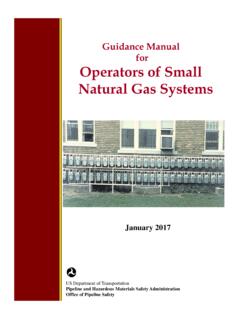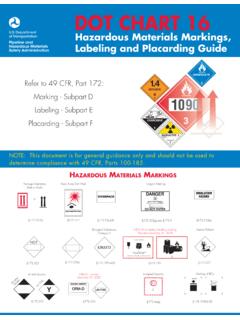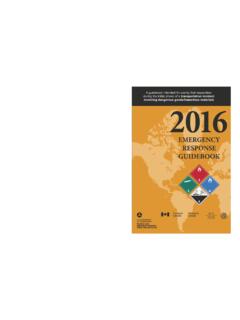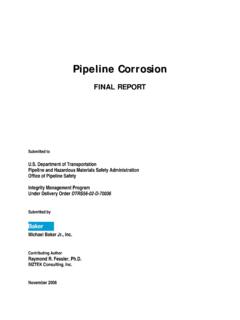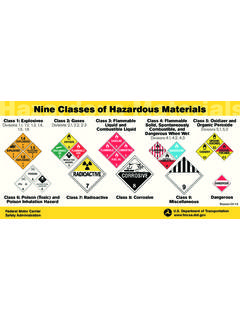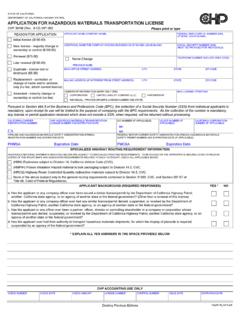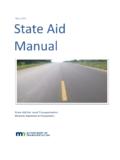Transcription of Hazmat Transportation Training Requirements - …
1 Hazmat Transportation . Training Requirements . An Overview of 49 CFR PARTS 172-173. 1. phmsa | PIPELINE AND HAZARDOUS MATERIALS SAFETY ADMINISTRATION. In this guide you will find details on Training regulations as well as definitions of terminology found in the HMR, such as Hazmat employer and Hazmat employee. There are also answers to the most frequently asked questions about Hazmat Transportation Training Requirements . Complying with these regulations can help you transport Hazmat more safely, and avoid unnecessary penalties. 2. IT'S THE LAW. Training is the best means of preventing, or reducing, hazardous materials ( Hazmat ) incidents in Transportation that are caused by human error. The Federal hazardous materials Transportation law (49 5101, et seq.) is the statute pertaining to the Transportation of Hazmat in the United States, and requires the Training of ALL Hazmat employees.
2 The purpose of this Training is to increase a Hazmat employee's safety awareness and to be an essential element in reducing Hazmat incidents. The Hazardous Materials Regulations (HMR) includes Training Requirements in several sections of Title 49 Code of Federal Regulations (CFR) as follows: GENERAL SPECIFIC MODAL. Air Vessel Highway , Receiving the required Training enhances employee safety and security, and increases employee productivity and skills. Effective Training also reduces incidents and accidents thereby reducing operating costs and losses from property damage, thus increasing profits. phmsa | PIPELINE AND HAZARDOUS MATERIALS SAFETY ADMINISTRATION 3. HMR Training Requirements . Each Hazmat employer must train and test their Hazmat employees, certify their Training , and develop and retain records of current Training .
3 Hazmat Training must include, or be: general awareness/familiarization;. function-specific;. safety;. security awareness;. in-depth security Training , if a security plan is required; and driver Training (for each Hazmat employee who will operate a motor vehicle). FREQUENCY OF Training . Initial Training of new Hazmat employees, or an employee who changes job functions, must be completed within 90 days of employment or change in job function. A new employee may perform Hazmat job functions before completing Training provided the employee does so under the direct supervision of a properly trained and knowledgeable Hazmat employee. Recurrent Training is required at least once every three years. The three- year period begins on the actual date of Training . Relevant Training received from a previous employer or source may be used to satisfy the Requirements provided a current record of Training is obtained from the previous employer or other sources.
4 4. Training conducted by OSHA, EPA, and other Federal or international agencies may be used to satisfy the Training Requirements in (a). to the extent that such Training addresses the components specified in paragraph (a) of this section (general awareness/familiarization;. function-specific; safety; security awareness; in-depth security Training , if a security plan is required; and driver Training for each Hazmat employee who will operate a motor vehicle). Training RECORDS. Training records must be kept by the Hazmat employer for each Hazmat employee, and must include the following: the Hazmat employee's name;. the completion date of the most recent Training ;. Training materials used (copy, description, or location);. the name and address of the Hazmat trainer; and certification that the Hazmat employee has been trained and tested.
5 Training records must be retained for each Hazmat employee for three years from the date of the last Training , and for 90 days after the employee leaves. phmsa | PIPELINE AND HAZARDOUS MATERIALS SAFETY ADMINISTRATION 5. The following terms are defined in section of the HMR. They will help you better understand the Hazmat Transportation Training Requirements . particularly your responsibilities. 6. DEFINITIONS. Training - a systematic program (consistent approach, testing, and documentation) that ensures a Hazmat employee has knowledge of Hazmat and the HMR, and can perform assigned Hazmat functions properly. See through Hazmat employer - a person who uses one or more employees regarding: transporting Hazmat in commerce;. causing Hazmat to be transported or shipped in commerce; or designing, manufacturing, fabricating, inspecting, representing, marking, certifying, selling, offering, reconditioning, testing, repairing, or modifying packagings as qualified for use in the Transportation of Hazmat .
6 The term Hazmat employer also includes any department, agency, or instrumentality of the United States, a State, a political subdivision of a State, or Native American Indian tribe engaged in offering or transporting Hazmat in commerce. This term includes a person who is self-employed, including an owner-operator of a motor vehicle that transports Hazmat in commerce. Hazmat employee - a person employed by a Hazmat employer, or person who is self-employed, and who directly affects Hazmat Transportation safety including: an owner-operator of a motor vehicle that transports Hazmat ;. a person who: loads, unloads, or handles Hazmat ;. designs, manufactures, fabricates, inspects, tests, reconditions, repairs, modifies, marks, or otherwise represents packagings as qualified for use in the Transportation of Hazmat .
7 Prepares Hazmat for Transportation ;. is responsible for safety of transporting Hazmat ; or operates a vehicle used to transport Hazmat . phmsa | PIPELINE AND HAZARDOUS MATERIALS SAFETY ADMINISTRATION 7. FREQUENTLY ASKED QUESTIONS. Q: May Hazmat employers/employees train and test themselves (an owner-operator)? A: Yes, self- Training is acceptable provided that all Training Requirements of are met. Q: Who certifies that an instructor is qualified to train, test, and certify in accordance with A: Except for certain FAA-required 14 CFR Training , the DOT. does not review or certify Training programs for pre-approval purposes. The employer must determine a trainer's qualifications based on the employer's needs. Q: Does the trainer who teaches and tests the Hazmat employee certify that the Hazmat employee is trained and tested?
8 A: It is the Hazmat employer's responsibility to ensure that a Hazmat employee is properly trained and tested; however, the Hazmat employer may designate an outside source to train, test, and certify on his/her behalf that the employee has been trained and tested. Q: If a designated outside source trains but does not test the employee, must the employee be tested to complete this Training ? A: Yes. The employee must be tested in order for the Training to meet the Requirements of the HMR. The Hazmat employer is responsible for ensuring each Hazmat employee is trained and tested. 8. Q: Must the test be in a written format or may a skill demonstration be used? A: Any test that ensures that the employee can perform the assigned duties in compliance with the HMR is acceptable.
9 Training and testing may be accomplished in a variety of ways: performance, written, verbal, or a combination of these. Q: Must the employee pass a test? A: The Requirements do not state that the employee must pass a test; however, an employee may only be certified in areas in which he/she can successfully perform his/her Hazmat duties. Q: Does IMDG Code, ICAO Technical Instructions, OSHA, or EPA. Training fulfill the HMR Requirements ? A: This Training may be used to the extent that the general awareness, function-specific, safety, and security Training and testing Requirements of the HMR are met. Areas not covered will require additional Training . Q: Who will enforce the Training Requirements in A: Enforcement is the responsibility of each DOT modal administration.
10 Compliance or noncompliance with the Training rule will be determined during safety and compliance reviews of shippers, carriers, and package manufacturers. phmsa | PIPELINE AND HAZARDOUS MATERIALS SAFETY ADMINISTRATION 9. Q: What type of fines would be involved? A: Violations of any Hazmat regulations including Training may be subject to a civil penalty of up to $77,114 for each violation. If the violation results in death, serious illness, or severe injury to any person or substantial destruction of property, the maximum civil penalty is $179,933. The minimum civil penalty amount for a Training violation is $463. Criminal violations may result in fines, imprisonment, or both. (See 49 CFR and ). Q: An office secretary types the required Hazmat description on a shipping paper at the direction of another, item by item.
